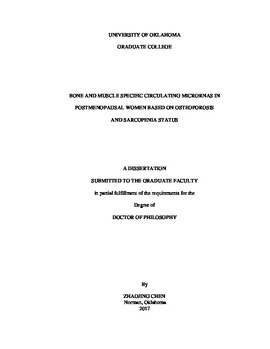| dc.description.abstract | MicroRNAs (miRNAs) are short, non-coding RNA molecules that fine tune posttranscriptional protein expression. Aging is accompanied by progressive declines in muscle mass and strength, and in bone mineral density (BMD). Although miRNAs in pathology have been extensively studied, the role of circulating miRNAs (c-miRNAs) in osteoporosis and sarcopenia has to date not been well studied. Purposes: 1) To identify specific c-miRNAs that are associated with bone and muscle status in postmenopausal women and to evaluate the use of these c-miRNAs as biomarkers of osteoporosis and sarcopenia; and 2) to determine the associations between specific c-miRNAs and muscle and bone variables. Methods: Seventy-five postmenopausal women aged 60 to 85 years old participated in this study. Body composition and areal BMD (aBMD) were measured by DXA. Volumetric BMD (vBMD) and bone strength were measured by pQCT. Muscle performance tests, including grip strength, gait speed, and countermovement jumps, were assessed. Bone status was classified based on aBMD T-scores: Osteopenia (-2.5 ≤ aBMD T-score ≤ -1) and osteoporosis (aBMD T-score ≤ -2.5). Two sets of criteria were used to classify sarcopenia status: 1) skeletal muscle mass index (SMI) < 5.5 kg/m2; and 2) SMI < 5.5 kg/m2 and low muscle strength (grip strength < 20 kg) or low gait speed (<0.8 m/s). Levels of c-miRNAs (miR-1, -21, -23a, -24, -100, -125b, -133a, -206) were analyzed using real-time PCR, and bone turnover markers were analyzed by enzyme-linked immunosorbent assay (ELISA). Results: There was no significant association between sarcopenia and osteopenia status in postmenopausal women. The sarco-osteopenia group had significantly lower body weight, jump power, and muscle CSA at 66% of the tibia than the normal and osteopenia groups (p < 0.05). Statistically, there were no significant differences in specific c-miRNAs based on sarcopenia and osteoporosis status. However, fold changes of miR-21 (FC=2.59) and -23a (FC=2.09) indicated upregulation and miR-125b (FC=0.46) indicated downregulation. The relative expression level of miR-125b was significantly negatively correlated with age (p < 0.05). The relative expression level of miR-21 was significantly negatively correlated with trochanter BMC and cortical vBMD at tibia 38% site (p < 0.05). Furthermore, the relative expression level of miR-23a was significantly positively correlated with TRAP5b levels (p < 0.05). Conclusion: There were no statistical differences in target circulating miRNAs (miR-1, -21, -23a, -24, -100, -125b, -133a, -206) based on bone and muscle status in postmenopausal women. However, fold changes of circulating miR-21, -23a, -125b indicated biological differential expression. Other circulating miRNAs need to be studied in the future. | en_US |
